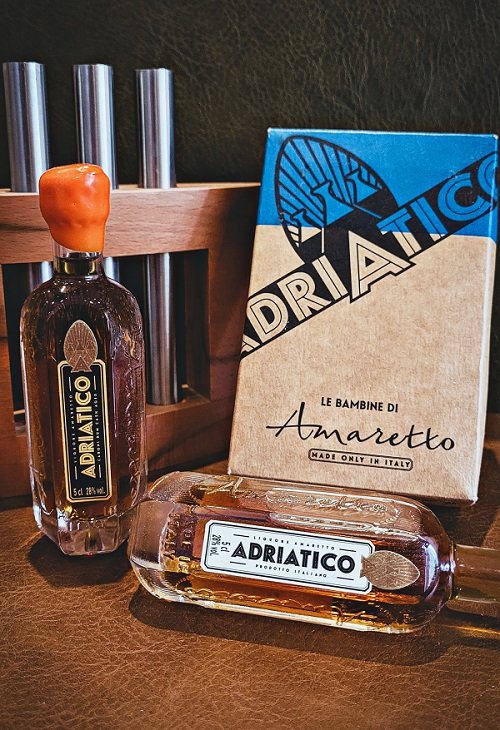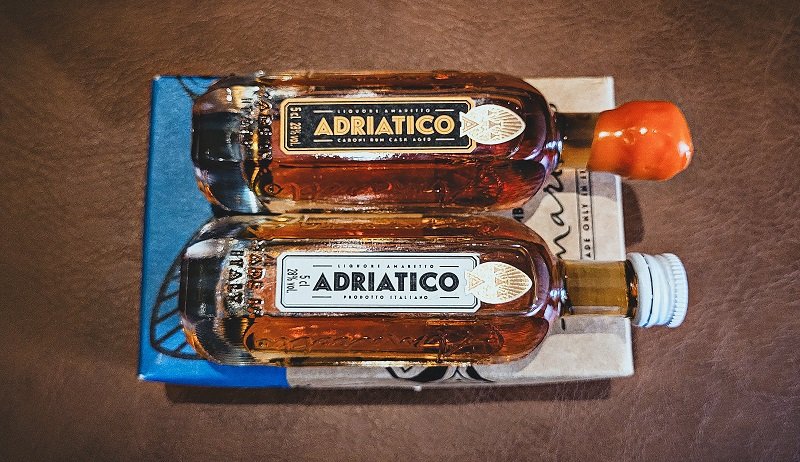Adriatico Amaretto
Origin: Italy / 28% / Price: ca. 28€ (Standard) / 55€ (Caroni Cask)
Amaretto…where to start? Let's put it this way: Amaretto is a category of liqueur that was so out of fashion and associated with negative examples like only few others (melon liqueur cough Midori cough). It generally came to my mind maybe a handful of times over the last few years. Adriatico has been around since 2018, although they have really been present internationally for the last two years. The praise and positive comments about it also got me interested, but there always seemed to be more important things than this "strange" category from days gone by.
Fortunately, the samples I received proved me wrong and to spoiler the verdict: "Positively surprised" is still an understatement.
But let's start, as always, at the beginning: the exterior. Or perhaps even further back, the general brand design. Apart from the bottles themselves, a really appealing design language also runs through the branding as a whole. A modern, clean website, even the packaging of the samples is very appealing. And then the bottles… I've become a bit critical of over-designed new brands that put a lot of effort and money into overused retro designs for otherwise modern companies, but GOD, this Art Deco inspired design is perfect. Iconic shape, iconic logo, for me as a lover of the art style from the 1920s and 30s a no-brainer, simply beautiful. Respect to everyone who contributed to these design decisions, greetings go out to Italy.
Now to the contents of those samples and bottles, which lead you to expect just as much quality inside of them. As you can read on every shop page, and rightly so: Adriatico is made exclusively from locally harvested Filippo Cea almonds from Apulia. It is not only the local part of it or the almond variety that is special, but it starts with the use of almonds in general. Because:
Most Amarettos are made without them or only with a few drops of almond extract, but actually produced with apricot kernels…
The almonds are roasted (which is quite noticeable while tasting), macerated in alcohol and the whole thing is then lightly spiced with cocoa, cinnamon, coffee, vanilla, and a touch of Italian sea salt. Adriatico advertises they use half the sugar content typically used in the industry, but I don't know the industry's figures. However, if you search, you will find that 1–2 retailers specify 205gr/l, which indeed sounds quite low for a liqueur at 28% and especially in this category. Remember that "Creme" liqueurs like "Creme de Banane" etc. have to contain a minimum of 250gr (in the EU).
As you can see from the notes below, I was particularly surprised and excited by the fact that a liqueur, especially Amaretto, with which one associates a monotony and plumpness from past decades, shows real development in the glass. In the first 20 minutes you can, in both cases, discover a lot and also notice the differences with both bottlings becoming bigger and more obvious. The Caroni Cask shows clear influences of rum, without distracting from the fact that it is an Amaretto. A little tropicality, molasses and cherry pits are the main features that add to the experience, more delicate notes like rose are gone, and it doesn't come across as salty as the Amaretto without rum barrel ageing.
Concerning drinks to try out, you can check out the articles on my own little creations, the French Bond, as well as the brilliant The Wind-Up with Islay Whisky or the Squeaky Wheel (coming soon) with Mezcal and the Solera Sidecar (coming soon). As with all modern spirits brands, Adriatico also offers a few recipes on its own website.
Amaretto Adriatico
Nose:
What surprises me: It needs time to breathe. A rare occurrence with liqueurs and especially less expected of an Amaretto, but nevertheless. At first, you think of the expected marzipan note, even if it is much more complex and more developed than in the Amarettos I have tasted so far (which, admittedly, are not many). But after 10–15 minutes, a small but elegant spectrum of aromas begins to emerge. Roasted almonds, a hint of toasted oak, I would even say a hint of the cocoa/coffee notes in between that, but too subtle to determine which of the two it could be, as well as a hint of rose. And it doesn't stop, another 10 minutes later, the spicier notes become more intense and salt becomes more noticeable.
Taste:
Raw honeycomb straight from the beekeeper into your hand, roasted almonds in the most beautiful form, along with salty almonds as well, coffee notes are the first thing to stand out after that, milk chocolate and cocoa, toasted oak, cinnamon, a hint of nutmeg
Finish:
Cinnamon, nutmeg, salted almonds, oak, manuka honey, walnut
Amaretto Adriatico Caroni Cask
Nose:
Similar surprise as with the standard bottling: It needs time. For the first 5 minutes, I could only detect minimal differences to its basic brother bottling, maybe a hint of molasses in the background, but nothing more. But as soon as the nose gets used to it and the liqueur has been in the glass for a while, quite the gap opened up between the two. Mainly a very intense note of orange oil, orange zest and a hint of papaya, the orange note with some lamp oil actually reminds me of Caroni. Fresh vanilla, toasted almonds, of course still noticeable marzipan notes and some ginger comes through. Salted caramel and a hint of fresh coffee beans also emerge later, as well as some cherry.
Taste:
Interesting, for half a second the exact same fresh honeycomb note as with the standard bottling, but then immediately fine molasses, a touch of funk, lamp oil, candle wax, orange zest, coffee, salted caramel, cherry pits, papaya, almond milk. A little creamier than the normal one, more substantial, but at the same time fresher, a certain sugar cane note gives it intensity and also that freshness.
Finish:
Cherry pits, cocoa beans, toasted oak, orange zests, molasses
The samples were provided by Kirsch Import, thanks!




